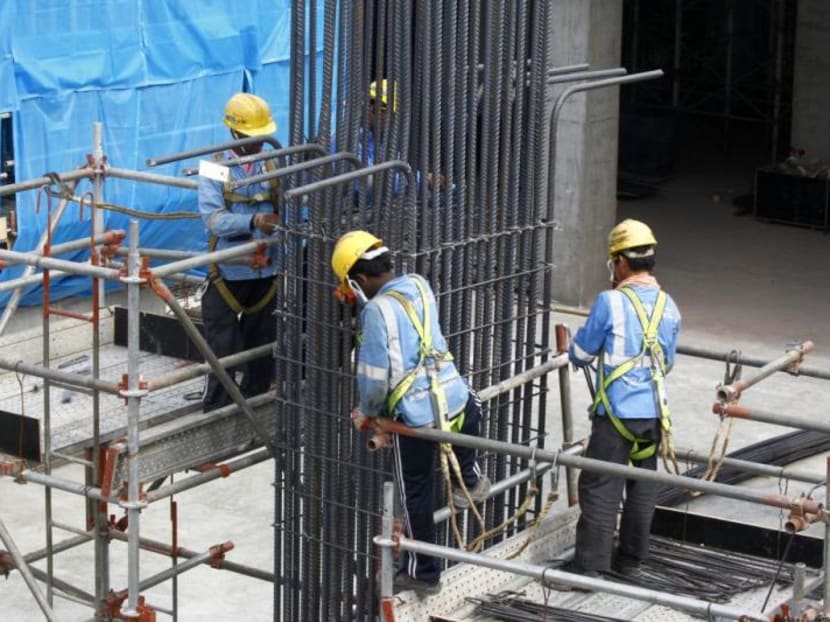Covid-19 backlog, tight resources contribute to recent spate in fatalities, say construction workers and firms

- A backlog of work due to Covid-19 and the pandemic's impact on workers have contributed to a recent spate of workplace fatalities
- A total of 27 workplace deaths were recorded so far this year, 10 involving the construction sector
- The authorities have unveiled plans to address this, but many felt that the effectiveness would be limited if companies do not have the resources to address underlying safety issues
SINGAPORE — The backlog of work due to the Covid-19 pandemic and its impact on workers here have contributed to the recent spate of workplace accidents and fatalities, said workers and company managers.
While the construction companies and workers who spoke to TODAY agreed that the Ministry of Manpower’s (MOM) plans for more stringent spot checks and penalties would send a strong signal to the industry, many felt that the effectiveness would be limited if companies do not have the resources to address the underlying safety issues.
This is particularly true for smaller firms, which face constraints when trying to implement measures to improve safety standards at work sites.
A total of 27 fatalities were recorded in the first half of the year, almost double that for the same period in 2019. Among the 27 deaths, 10 were in construction, of which six were from smaller firms with a total workforce of fewer than 100 workers.
COVID-19 IMPACT ON WORKLOAD AND WORKERS
The pandemic has halted much of construction activities for a long period, piling up work load and project deadlines.
“This pent up demand coupled with tighter project deadlines may result in some firms not investing adequate time and resources to focus on WSH (workplace safety and health) issues at their workplaces,” said Mr Seah Kok Hua, senior manager at integrated construction company Samwoh Corporation.
“Clients rush the company, then the supervisors rush the workers. Then when they rush, they sometimes forget to take note of safety,” said Mr Selvamani Babu, project manager at Ask M & E, a company that does plumbing and sanitising work, and employs about 150 workers.
In a written parliamentary response in January, MOM said that it had resumed approvals for construction, marine shipyard and process sector workers to enter Singapore from November 2021, after a period of tightening during the height of Covid-19.
Some of these newer workers may also be susceptible to a higher safety risk, said some companies.
“Some new workers who are fresh, with no experience working on site in Singapore, they would question the need to follow safety procedures as they are not yet used to it,” said Mr Muhammad Syahmi Abdul Wahab, project coordinator at Axiom Construction and Design, which has about 50 workers.
Meanwhile, some migrant workers said that problems arising from the pandemic have weighed heavily on their minds, potentially distracting them at work.
“Some of them have family problems, or haven’t seen their family for years. They come to work very sad, sometimes not focused,” said Mr Anandaraj Sakthivel, project manager at Best Construction Service, which employs about 70 workers.
'SAFETY = MORE TIME AND MONEY'
Some bigger companies are already taking steps to improve workplace safety.
“We will continue to look into the use of technology that can further improve the current safety and health processes,” said Mr Allan Low, senior environment, health and safety (EHS) manager at Teambuild Construction Group, which has about 1,200 employees.
Similarly, Mr Howard How, EHS director of publicly listed company Boustead Projects, said they will deploy “smart sensing wearable tags technology coupled with proximity sensors” and use video analytics to better monitor workers and alert them of hazards at the work site.
Smaller firms, on the other hand, feel the pinch of every dollar they put into improving safety conditions.
The costs to erect safety structures and barricades, or to provide better personal protective equipment for workers for example, add up very quickly, said these companies.
Dedicating some of their already small pool of workers to be safety spotters for certain tasks and having more regular pauses at work to hold safety reminder briefings would also slow work progress, putting companies at risk of having to bear liquidated damage if they cannot meet project deadlines.
“Safety basically equals more time and more money. Otherwise, why would anyone take the risk of doing things dangerously if they have no choice? Everybody wants to come back safely after work,” said a director of small firm A N R Construction & Engineering who wants to be known only as Mr Goh.
Some companies feel that clients such as project developers ought to chip in by paying more and giving longer deadlines to improve workplace safety.
“If you tell a client or the end user, ‘you need to pay more to help make the workplace safer’, would a client do that? Chances are, right now, they’ll say no,” said Mr Goh.
STICK APPROACH USEFUL, BUT NOT ENOUGH
Meanwhile, firms and workers said that closer monitoring and reviewing the demerit points system are useful in signalling companies to pay more attention to safety.
“Contractors will be mindful when taking up jobs to not go beyond their resource capacity, as they know that safety non-performance would have greater consequences due to MOM’s tightening of measures,” said Mr Seah.
While deploying additional WSH personnel can help spot and deter poor safety practices, Mr Wong Hong Sean, project manager at Chee Seng Engineering, said that this does little to improve the underlying safety culture, as workers would just put on their best behaviour in front of the safety officer.
“It’s like the army. Only when your sergeant major is around, you’ll do things kilat (to shining perfection). Similar logic here with workers,” said Mr Goh.
The Migrant Workers’ Centre (MWC), a non-government organisation that seeks to improve the well-being of migrant workers in Singapore, said on Friday (July 1) that it has been conducting outreach activities to educate migrant workers on work safety measures.
“MWC will also be piloting an initiative to offer online bite-size courses on workplace safety in a bid to uphold higher safety and health standards,” said the organisation.
The Singapore Contractors Association Limited (Scal) said in response to TODAY’s queries that it had shared with MOM the need for an incentives approach for builders who have good safety records.
“(Measures include) placing more emphasis on safety performance in tender evaluation, and for firms to enjoy lower Wica insurance premiums,” said Mr Yong Jian Rong, chairman for the WSH subcommittee at Scal, referring to the insurance coverage for workers under the Work Injury Compensation Act.
“Both of these suggestions recognise and spur companies to improve and enhance their safety standards at construction sites.”













